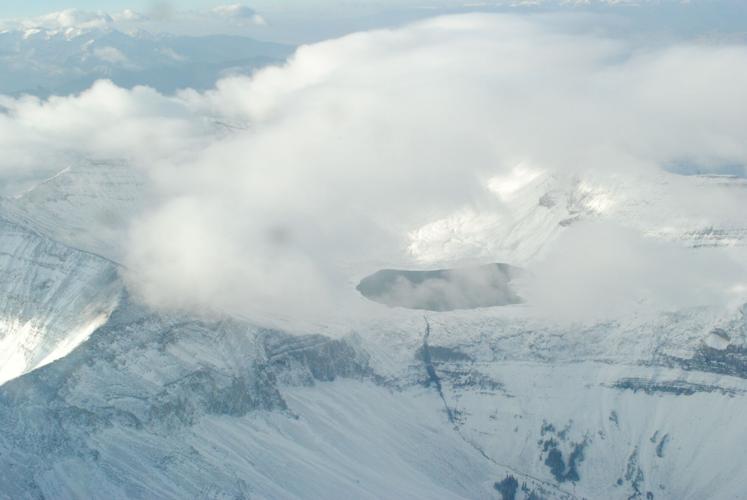
As average temperatures warm and more people move to southwest Montana in the coming decades, ecosystems will change, and pressures on wildlife will mount, predicts Sierra Harris, climate change coordinator for the Greater Yellowstone Coalition.
One can get a sense of the scale and pace of habitat fragmentation while flying over the Gallatin and Madison ranges — the focus area for a coalition’s 2018 land management recommendations to the U.S. Forest Service.
Where jagged peaks drop into large expanses of forest, roads and trails criss-cross the landscape, and houses creep out from under the trees. West of the matrix, a waterfall cascades from Cedar Lake, where Hilary Eisen once caught large westslope cutthroat trout.
Under the Custer Gallatin National Forest’s new land management plan, the trout are listed as a “species of conservation concern,” meaning the agency is concerned about the species’ ability to persist into the future and will prioritize managing habitat with the fish in mind.
Eisen is the policy director for the Winter Wildlands Alliance, and her organization is among the coalition of businesses, landowners and conservation and recreational interest groups that make up the Gallatin Forest Partnership.
Back in 2018, the partnership asked the Forest Service to consider protecting some key areas within the Madison and Gallatin Mountains as it revised the overarching land management plan for the Custer Gallatin National Forest.
Groups in the partnership “came together with the agreement that they were willing to give and take,” Eisen said, and the coalition’s final proposal outlined 124,000 new acres of recommended wilderness in both ranges.
The agreement was endorsed by more than 1,000 local citizens and businesses, but there were people on both extremes of the spectrum — some who wanted to maximize wilderness and others who wanted to expand recreational and extractive uses — who weren’t satisfied.
The Gallatin Yellowstone Wilderness Alliance, which advocated for a much larger swath of wilderness protections, released a report criticizing the partnership’s agreement, arguing that it was exclusionary and recreation-centric.
The agreement will have “far-reaching impacts of the wildlife and wilderness values of the Gallatin and Madison Ranges that include fragmentation of the (Hyalite Porcupine Buffalo Horn) Wilderness Study Area,” according to the group’s report.
Ultimately, the Forest Service incorporated most of the coalition’s proposal into its final plan this January, with some boundary adjustments and discrepancies. Members of the partnership want to have their recommendations adopted in full, so now they are taking their request to Congress.
Some of the partnership’s victories included the addition of a 13,000-acre recommended wilderness area in Cowboy Heaven — the area between the Spanish Peaks unit of the Lee Metcalf Wilderness and Bear Trap Canyon.
Alex Blackmer, a spokesperson for Wild Montana, said the Forest Service can change recommended wilderness areas with each new land management plan, and “with the growth we’re seeing and the climate changing, locking those down now is super important.”
“If you don’t, things will continue to develop, and the potential for them to be permanently protected will be gone,” he said. An official wilderness designation requires an act of Congress, and federal legislation would trump the forest plan’s direction.
Ultimately, the partnership hopes to preserve existing recreational opportunities in the two ranges, but it also wants to connect and protect varied, intact landscapes so wildlife can better adapt to the changes ahead, according to Harris.
As water temperatures warm in the Greater Yellowstone area, cold water refuges for westslope cutthroat trout will recede toward the highest elevations. At the same time, development will encroach on lower-elevation habitats that support large mammals like elk.
“What makes the recreation here so amazing is that we have opportunities to encounter native wildlife. That’s the core of this area, and we don’t want to lose that in the face of growing human pressure,” Eisen said. “That’s at the foundation of our agreement.”
Last Friday, members of the Gallatin Forest Partnership pointed out some of the key wildlife migration corridors from a single-engine plane operated by Gary Kraft of EcoFlight — a nonprofit that provides aerial tours to educate people on conservation and public lands issues.
As the plane approached Ennis Lake, a band of clouds passed over Cowboy Heaven, and then it flew south over the Madison Mountains and Big Sky.
The plane turned east over the 155,000 acre Hyalite Porcupine Buffalo Horn Wilderness Study Area, which was split up into the Gallatin Recommended Wilderness Area and two “backcountry” areas in the final plan.
Further north, views of the snow capped peaks around the Hyalite Creek watershed appeared. The Forest Service marked the drainage as a “recreation emphasis area” in the plan, which will enable it to conduct some management activities, like timber harvests.
“A sign the Gallatin Forest Partnership is serving a lot of interests is that we get pushback from both sides — people who want more motorized access, development and timber work, and people who want more wilderness protections,” Eisen said. “We have to recognize there are a lot of values here, and no one thing is dominating them.”